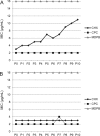Developing a New Generation of Antimicrobial and Bioactive Dental Resins
- PMID: 28530844
- PMCID: PMC5502962
- DOI: 10.1177/0022034517709739
Developing a New Generation of Antimicrobial and Bioactive Dental Resins
Abstract
Dental caries is prevalent, and secondary caries causes restoration failures. This article reviews recent studies on developing a new generation of bioactive resins with anticaries properties. Extensive effects were made to develop new antimicrobial composites, bonding agents, and other resins containing quaternary ammonium methacrylates to suppress plaque buildup and bacterial acid production. The effects of alkyl chain length and charge density and the antimicrobial mechanisms for chlorhexidine, nano-silver, quaternary ammonium methacrylates, and protein-repellent agents were discussed. Synergistic effects of contact-killing and protein-repellent properties were shown to yield the greatest biofilm-inhibition effects. The combination of antimicrobial, protein-repellent, and calcium phosphate nanoparticle remineralization was suggested to provide maximal anticaries effects. In addition, for use orally, cytotoxicity and biocompatibility were important considerations for the new bioactive materials. Furthermore, rather than kill all bacteria, it would be more desirable to modulate the oral biofilm compositions via bioactive resins to suppress cariogenic/pathogenic species and promote benign species. For widespread clinical use of the new antimicrobial and therapeutic materials, whether they would induce bacterial drug resistance needs to be determined, which requires further study. Nonetheless, the new generation of bioactive anticaries resins with therapeutic and biofilm acid-inhibiting properties has the potential to substantially benefit oral health.
Keywords: anti-caries; antibacterial; composites and adhesives; modulating biofilm compositions; remineralization; therapeutic.
Conflict of interest statement
The authors declare no potential conflicts of interest with respect to the authorship and/or publication of this article.
Figures






Similar articles
-
Effect of dimethylaminohexadecyl methacrylate mass fraction on fracture toughness and antibacterial properties of CaP nanocomposite.J Dent. 2015 Dec;43(12):1539-46. doi: 10.1016/j.jdent.2015.09.004. Epub 2015 Sep 25. J Dent. 2015. PMID: 26404407 Free PMC article.
-
Dental plaque microcosm response to bonding agents containing quaternary ammonium methacrylates with different chain lengths and charge densities.J Dent. 2013 Nov;41(11):1122-31. doi: 10.1016/j.jdent.2013.08.003. Epub 2013 Aug 13. J Dent. 2013. PMID: 23948394 Free PMC article.
-
Protein-repellent and antibacterial dental composite to inhibit biofilms and caries.J Dent. 2015 Feb;43(2):225-34. doi: 10.1016/j.jdent.2014.11.008. Epub 2014 Dec 3. J Dent. 2015. PMID: 25478889 Free PMC article.
-
Nanotechnology strategies for antibacterial and remineralizing composites and adhesives to tackle dental caries.Nanomedicine (Lond). 2015 Mar;10(4):627-41. doi: 10.2217/nnm.14.191. Nanomedicine (Lond). 2015. PMID: 25723095 Free PMC article. Review.
-
Clinical efficacy and the antimicrobial potential of silver formulations in arresting dental caries: a systematic review.BMC Oral Health. 2020 Jun 3;20(1):160. doi: 10.1186/s12903-020-01133-3. BMC Oral Health. 2020. PMID: 32493272 Free PMC article.
Cited by
-
The Antibacterial and Remineralization Effect of Silver-Containing Mesoporous Bioactive Glass Sealing and Er-YAG Laser on Dentinal Tubules Treated in a Streptococcus mutans Cultivated Environment.Pharmaceuticals (Basel). 2021 Nov 4;14(11):1124. doi: 10.3390/ph14111124. Pharmaceuticals (Basel). 2021. PMID: 34832906 Free PMC article.
-
Novel Dental Low-Shrinkage-Stress Composite with Antibacterial Dimethylaminododecyl Methacrylate Monomer.J Funct Biomater. 2023 Jun 25;14(7):335. doi: 10.3390/jfb14070335. J Funct Biomater. 2023. PMID: 37504831 Free PMC article.
-
Starvation Survival and Biofilm Formation under Subminimum Inhibitory Concentration of QAMs.Biomed Res Int. 2021 Jan 14;2021:8461245. doi: 10.1155/2021/8461245. eCollection 2021. Biomed Res Int. 2021. PMID: 33511211 Free PMC article.
-
Multifunctional Coatings of Titanium Implants Toward Promoting Osseointegration and Preventing Infection: Recent Developments.Front Bioeng Biotechnol. 2021 Dec 7;9:783816. doi: 10.3389/fbioe.2021.783816. eCollection 2021. Front Bioeng Biotechnol. 2021. PMID: 34950645 Free PMC article. Review.
-
Long-term application of silver nanoparticles in dental restoration materials: potential toxic injury to the CNS.J Mater Sci Mater Med. 2023 Oct 19;34(11):52. doi: 10.1007/s10856-023-06753-z. J Mater Sci Mater Med. 2023. PMID: 37855967 Free PMC article. Review.
References
-
- Bayne S, Petersen PE, Piper D, Schmalz G, Meyer D. 2013. The challenge for innovation in direct restorative materials. Adv Dent Res. 25(1):8–17. - PubMed
-
- Beyth N, Domb AJ, Weiss EI. 2007. An in vitro quantitative antibacterial analysis of amalgam and composite resins. J Dent. 35(3):201–206. - PubMed
-
- Beyth N, Yudovin-Farber I, Bahir R, Domb AJ, Weiss EI. 2006. Antibacterial activity of dental composites containing quaternary ammonium polyethylenimine nanoparticles against Streptococcus mutans. Biomaterials. 27(21):3995–4002. - PubMed
-
- Chatzistavrou X, Fenno JC, Faulk D, Badylak S, Kasuga T, Boccaccini AR, Papagerakis P. 2014. Fabrication and characterization of bioactive and antibacterial composites for dental applications. Acta Biomater. 10(8):3723–3732. - PubMed
Publication types
MeSH terms
Substances
Grants and funding
LinkOut - more resources
Full Text Sources
Other Literature Sources
Medical

